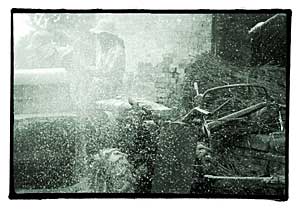 The Park Gallery, run by photographer Navin Joshi and his family, lies in an old house off Pulchowk. Joshi took over the running of the gallery after the death of his father in 1988 and, like his father, uses his gallery to promote local artists and their artwork.
The Park Gallery, run by photographer Navin Joshi and his family, lies in an old house off Pulchowk. Joshi took over the running of the gallery after the death of his father in 1988 and, like his father, uses his gallery to promote local artists and their artwork.
The current exhibition, Three Men's Perspectives, is an amalgam of three distinctly different perspectives on Nepal. Joshi's photographs capture tiny everyday actions, scenes, and objects that we take for granted. The images are presented in variations of black and white, because he believes that this eliminates the distracting colours in scenes that cause our eyes to dismiss them as mundane. After all, everything is worthy of being photographed. Drying chillies and hanging garlic, beaten wheat and the mani around a Buddhist temple that our hands run over but our eyes ignore-all these have been captured and the importance of daily routines born of old traditions have been lovingly rendered into detailed, evocative records.
Nick Dawson, a British man who has lived in Nepal since 1997, has a very different aesthetic. His work is abstract, quirky and visceral. His photographs are alive with colours and textures. One feels like one could reach in and touch the veined leaves, and the bright, fleshy pink and orange petals of his flowers, and that one's fingers might be bruised by the rough, grainy surfaces that dominate his photographs. The photographs range from the very abstract to the very detailed. A photograph titled Deep Blue is an unidentifiable, fantastically blue mosaic which sucks you in no matter where you are in the gallery. When I asked him what it was, he grinned and said that it is the swimming pool at the Hyatt. Another photograph called Light Switch is a classic image of Nepali workmanship: a crooked light switch that cannot help but bring a smile to your face. Dawson talks about Nepal being a mixture of the traditional and the modern, and his perspective comes through in his idiosyncratic, whimsical images of crooked light switches and turmeric sellers coated in the yellow powder that is their livelihood, smoking imported, white cigarettes.
The third artist in the show is Kishor Kayastha, a 23-year-old photographer from Bhaktapur who was exposed to the world of photography at the age of nine at his grandfather's studio. This man's photographs radiate a tender romanticism. His images are dreamy and permeated with a sense of expectation, as if something were just about to happen. Temples just barely visible through thick mist, a girl looking out onto an open vista, and stick figures that are childhood endeavours at art stare out at one from the wall, each image the portrayal of a possibility. Kayastha talks of the many different processes that he works with in the darkroom in order to achieve the results he has already pictured in his mind's eye. As he talks it becomes apparent that all of his work is laden with meaning. He points to a photograph of a girl with her hair swinging backwards, away from her head, and dissolving into storm clouds. He says that the photograph is a representation of every Nepali girl's dreams. A Nepali girl has a dreamy quality, he says, she has hidden hopes and desires, and when she gets married, all of these hopes dissolve and are swept away like clouds in the wind. Kayastha uses his technical skill and innovation to flesh out his insights. The result is a wonderful collection of vivid, glowing photographs.
It is quite an experience to walk into one space and be confronted with three such different perspectives on Nepal and Nepali life. Each photographer has his own style and within minutes one can match the photograph with the artist. Navin Joshi talks about his efforts to expose the public to various different styles and viewpoints. He has done an admirable job in this exhibition. The odd and wonderful thing about the three such distinctive collections is that they all have one underlying common theme: that every little aspect of life is worthy of being photographed, and that there is beauty and mystery in the simplest things.


